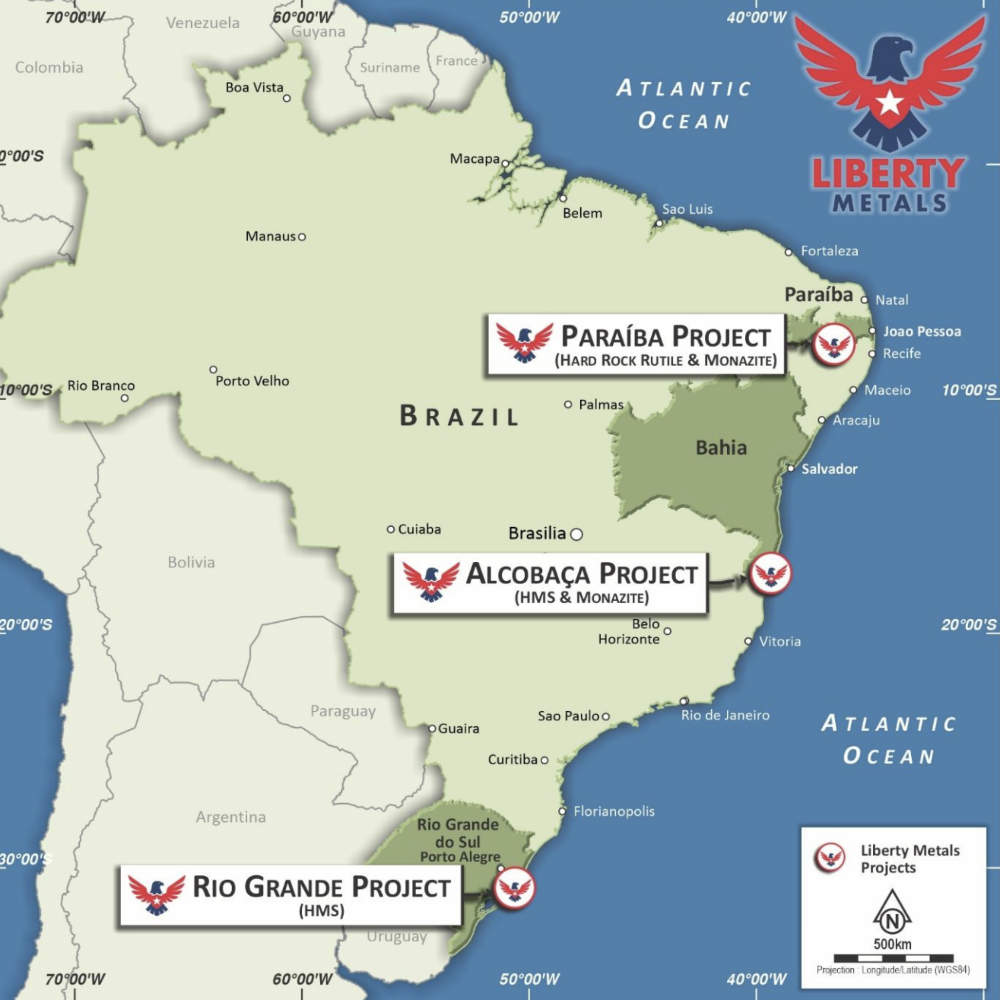Liberty Metals eyes titanium, rare earths with acquisition of Brazilian critical mineral plays

Liberty Metals’ Brazilian acquisitions give it exposure to titanium and rare earths. Pic: Getty Images
- Liberty Metals acquiring three critical mineral projects in Brazil prospective for titanium and rare earths
- Projects span Paraiba, Rio Grande and Alcobaca with high-grade rutile and heavy mineral sands
- Systematic, low cost exploration planned to quickly establish initial resources
Special Report: Liberty Metals has stepped into Brazil’s critical minerals space with the acquisition of three district-scale projects highly prospective for titanium and rare earths.
They are the Paraiba hard rock rutile project in Paraíba state, the Rio Grande heavy mineral sands project in Rio Grande do Su state and the Alcobaca heavy mineral sands and rare earths project in Bahia state.
They give Liberty Metals (ASX:LIB) three complementary development pathways in Brazil – a Tier 1 mining jurisdiction with a stable mining code, excellent infrastructure and a skilled workforce.
It also comes as the US, EU and Australia push to secure supplies of critical minerals that are seeing increasing supply constraints.
“This acquisition marks a transformative step, establishing Liberty’s footprint across Brazil’s leading mineral provinces with three high-value critical mineral projects,” non-executive chairman Nicholas Katris said.
“Collectively these assets create a diversified platform across titanium and rare earths within a Tier 1 jurisdiction increasingly aligned with the United States’ critical-minerals strategy to strengthen secure, transparent supply chains”

Brazilian projects
Paraiba is a unique, high-grade rutile project covering 120km2 in Paraíba’s Borborema geological province, which has a measured state-wide reserve of 1.14Mt of rutile and hosts existing titanium operations such as the Tronox Paraíba mine.
Borborema closely resembles Cameroon’s emerging rutile province with both regions being originally part of the same tectonic system and similar high-grade, kyanite-rich source rocks that indicate comparable potential for major hard rock rutile deposits.
Initial lab testing of proximal rutile crystals have confirmed high-purity mineralisation with multiple samples grading >90% titanium dioxide with a peak of 94.7%, which Katris said indicated potential for a premium titanium product.
Rio Grande is a 234km2 heavy mineral sands project that is highly prospective for ilmenite, rutile and zircon.
It is immediately adjacent to Rio Grande Mineração’s advanced South Atlantic project that has a JORC resource of 771Mt at 3% total heavy minerals.
Rio Grande is a direct analogue to South Atlantic, which is advancing towards a prefeasibility study and has secured the environment licence for a processing plant.
“The proven geology and shallow, near-surface deposits provide a straightforward, low-cost path to defining a significant resource comprising rutile, ilmenite and zircon,” Katris said.
Meanwhile, the 55km2 Alcobaca project marks LIB’s entry into the highly sought-after rare earths market thanks to its strong potential for titanium, zircon and monazite-hosted REEs.
It is adjacent to the Bahai project acquired by major US critical minerals producer Energy Fuels for US$27.5m, which validates the region’s REE potential.
Future facing
LIB has worked out plans for systematic, cost-efficient exploration programs across its Brazilian portfolio aimed at quickly establishing initial resources for each project.
At Paraiba, this will include detailed property-wide geological and structural mapping to identify the factors controlling high-grade rutile mineralisation.
This will be followed by structured trenching and channel sampling across identified mineralised zones to confirm continuity and surface grade potential before drilling to evaluate the depth, shape and extent of the rutile-bearing metamorphic units.
The company will also collect and review all available historical exploration data for Rio Grande before it launches ground penetrating radar surveys to map the subsurface structures of the coastal plain and identify potential heavy mineral trap sites.
An initial program of shallow auger and/or aircore drilling will then evaluate the thickness, grade and continuity of mineralisation across the most promising concession areas to define an initial JORC resource.
Similarly, exploration at Alcobaca will begin with a thorough review of regional geological and geophysical datasets.
GPR surveys will be used to identify potential heavy mineral trap sites, followed by shallow auger and/or aircore drilling to assess mineralisation thickness, grade and continuity.
The drilling will focus on quantifying monazite content to help define a maiden JORC resource.
This article was developed in collaboration with Liberty Metals, a Stockhead advertiser at the time of publishing.
This article does not constitute financial product advice. You should consider obtaining independent advice before making any financial decisions.
Related Topics

UNLOCK INSIGHTS
Discover the untold stories of emerging ASX stocks.
Daily news and expert analysis, it's free to subscribe.
By proceeding, you confirm you understand that we handle personal information in accordance with our Privacy Policy.








